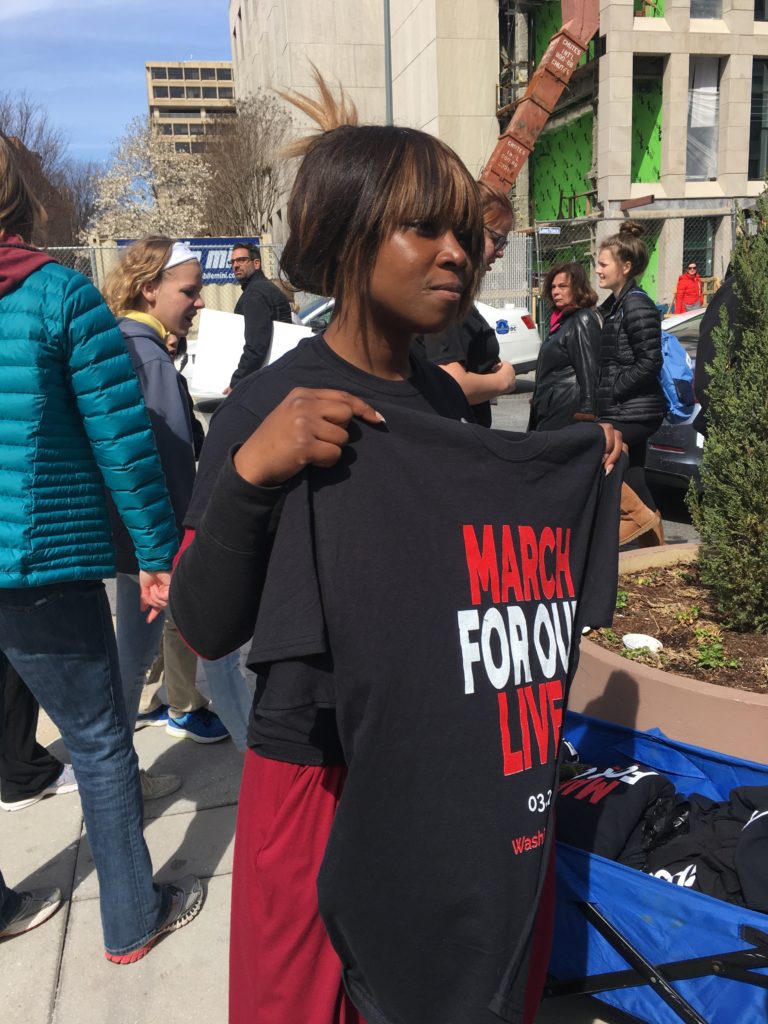
By Cayla Cade
Shatavias Shivers drove 10 hours from South Carolina with a truckload of t-shirts to arrive at the March for Our Lives before 6 a.m. to get a prime selling spot for a march that started four hours later.
Her goal was to spread awareness of gun control which was the focus of the student-sponsored march attended by tens of thousands from all over the country. The March 24 rally in Washington, DC was quickly put together by young activists to raise awareness of gun control after 14 high school students and three teachers were murdered by a student gunman at a Parkland, FL high school on Feb. 14.
Shivers designed her black t-shirts with words in red and sold them for $10. On the front, the shirt states, “March for Our Lives.” On the back it declares, “Enough is Enough.” She plans to donate the profits to Marjory Stoneman Douglas High School, where the 17 people killed attended and worked. Shivers said the march was, “A phenomenal turnout,” and t-shirts were going quickly.
Dozens of vendors were selling t-shirts, buttons, lanyards, bumper stickers and signs at the event. Some lanyards had “Black Lives Matter,” “Not my President,” and “March for Our Lives,” printed on them. “Stop Gun Violence,” “A New Day is on the Horizon, Oprah 2020,” were stamped onto buttons.
Some vendors were there to raise awareness, some were there strictly for profit, and some for both.
Glenn Cordon, who calls himself a “professional t-shirt peddler,” was there strictly to make money. He drove down from New Jersey to sell green and white tie-dye shirts in large and extra-large for $5 out of a push cart in the middle of a throng of marchers. The profits, he said, would go to him after paying for the shirts.
Omar Malik, another vendor with a large rectangular table, was being paid to sell his march merchandise, which included t-shirts and buttons. Some of the profit from Malik’s sales were going to Citizens Super PAC for America in Cleveland, Ohio. The non-profit is classified as a social welfare organization, whose primary activity is civil rights, social action, and advocacy. He sold about 20 dozen t-shirts and buttons, with his buttons being the biggest seller.
To purchase merchandise, most people paid cash. But there were other more modern tech ways to pay. Some vendors let customers pay with debit or credit cards, PayPal, and even bitcoin.
In addition to selling souvenirs, some vendors and even marchers were giving away for free $1.05 price tags to attach to collars or wrists. (They are available to print out on The March for Our Lives website.) The tag refers to the $3.3 million the National Rifle Association donated to Florida Republican Sen. Marco Rubio divided by the number of students –3.1 million –in Florida. The bright- orange tag demands, “Don’t Put a Price on Us”.
April Cisneros bought buttons to send back to her family in Los Angeles. “I thought they would think they were cool,” she said. Cisnersos’ mother is a teacher and her father is a police officer. She worries often about her mother’s school getting shot up, and is in favor of stricter gun control laws. “Growing up in Los Angeles, there were many shootings on her street,” she said. “It was “scary.’


